If I were a writer, I would turn Taivassalo’s kantele into a science fiction story
Blog
March 13, 2024
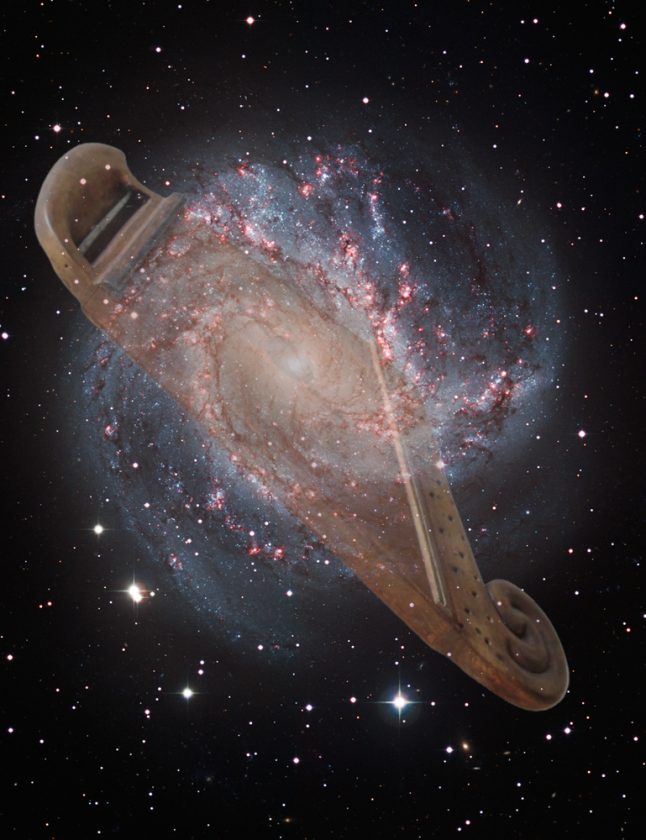
SM124 and the galaxy M83 (NASA and STScI / Hubblesite). Image Credits: European Southern Observatory. “This is an image of the galaxy M83, taken by the European Southern Observatory’s Wide Field Imager on the ESO/MPG 2.2-meter telescope at La Silla, Chile.”.
The Sibelius Museum kantele SM124 may be the only Taivassalo kantele in Finnish museums.
It has so many unique and special features that I’d write science fiction about it if I could.
The maker of this instrument has put a lot of effort into the planning and execution of the design, but what she or he wanted to convey with this particular design will never be known.
For me, the sound hole reminds me of galaxies and planets, the tuning peg holes of the starry sky, and the tip coil carved in the shape of an ear of communication: “Can anyone hear out there?”

There is almost no information about the history of the kantele. On the bottom of the instrument is written in Swedish: “Från Töfsala ink. Sept. 1934”. This means: from Taivassalo, bought in September 1934. The museum also has information that the instrument was bought by prof. Andersson (Otto Andersson) via Turpela. According to the Geni.com website, the Turpela family is mainly concentrated in Alajärvi. Juha (or Johan) Eeli Turpela (1890-1958), born in Alajärvi, died in Turku, so there is a small chance that he could be the broker of this instrument.
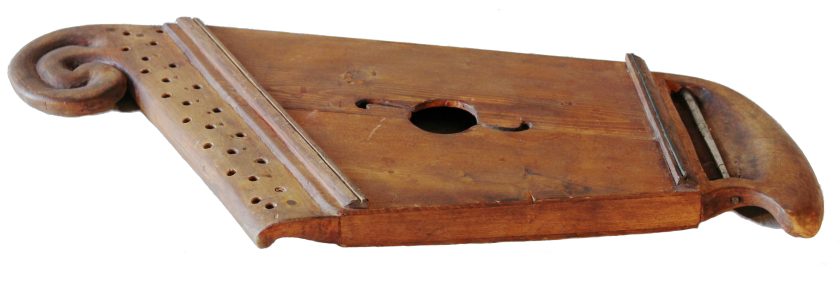
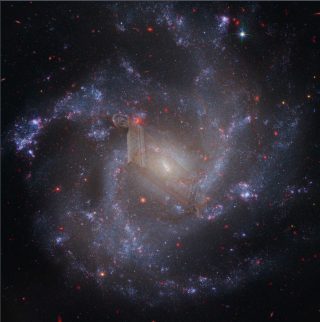
SM124 combined with the original image of the galaxy NGC 5468 (Hubblesite). Image credits: NASA, ESA, CSA, STScI, Adam G. Riess (JHU, STScI). “This image of NGC 5468, a galaxy located about 130 million light-years from Earth, combines data from the Hubble and James Webb space telescopes. This is the farthest galaxy in which Hubble has identified Cepheid variable stars. These are important milepost markers for measuring the expansion rate of the universe.”
The instrument is not hollowed out but glued together (with the help of a few small nails). The maker clearly did not aim for the shape of the traditional Finnish-Karelian hollow kantele.
The resonance chamber is very low, and the relationship between the vibrating lengths of the strings and the angles of the sides is different from that of traditional small kanteles: the body is wider in relation to the length than in traditional hollow kanteles, where the tip angle is sharper and the end, the ponsi side, is significantly shorter than the other sides.
On the ponsi and tuning peg sides of the soundboard there are string thresholds (or perhaps bridges? in Finnish the word is “kielikynnys”) over which the strings have passed to their fastenings in the metal bar (varras) and tuning pegs. In the middle of the wooden threshold there is a groove with a thin iron bar embedded in it – this bar has disappeared from the tuning peg side. The iron has affected the tone and timbre of the strings compared to the wooden threshold.
The tuning peg pinblock (I wonder if that is the right word?), which narrows towards the edge and curves downwards, is glued into the frame formed by the short and long sides of the kantele and the top and bottom plates.


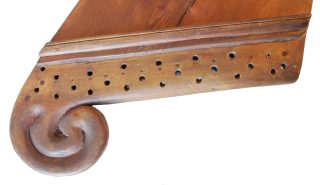 There are 23 tuning pin holes for metal tuning pegs, staggered in three more or less straight rows. A few holes have wooden plugs, so it is possible (and likely) that the position of the tuning pins has been changed, e.g. because the pegs no longer held the tuning and new holes were made at some point.
There are 23 tuning pin holes for metal tuning pegs, staggered in three more or less straight rows. A few holes have wooden plugs, so it is possible (and likely) that the position of the tuning pins has been changed, e.g. because the pegs no longer held the tuning and new holes were made at some point. 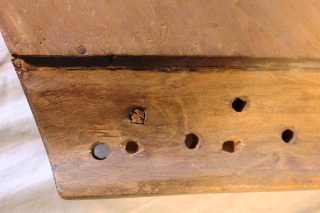 If all 23 strings had been in place at the same time, they would have been so close together that it would have been difficult to pluck any one of them. Strumming technique? That might have worked. What if the builder had used Lönnrot’s innovative chromatic tuning, where the chromatic notes of the scale are strung lower than the diatonic notes, i.e. some strings are closer to the soundboard? Hmmm…
If all 23 strings had been in place at the same time, they would have been so close together that it would have been difficult to pluck any one of them. Strumming technique? That might have worked. What if the builder had used Lönnrot’s innovative chromatic tuning, where the chromatic notes of the scale are strung lower than the diatonic notes, i.e. some strings are closer to the soundboard? Hmmm…
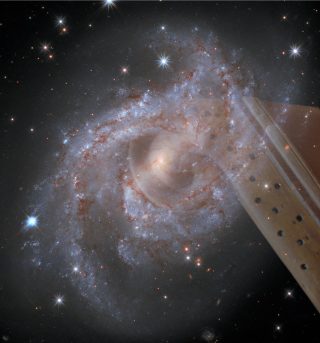
The “earlobe” of the SM124 and the galaxy NGC 2525. Image credits: NASA, ESA, and A. Riess (STScI/JHU) and the SH0ES team. Acknowledgment: M. Zamani (ESA/Hubble). “Astronomers using NASA’s Hubble Space Telescope captured the quick, fading celebrity status of a supernova, the self-detonation of a star. The Hubble snapshots have been assembled into a telling movie of the titanic stellar blast disappearing into oblivion in the spiral galaxy NGC 2525, located 70 million light-years away.”
Viewed from above, the very unusual shape of the tip resembles a human earlobe. Precise hearing and listening are required of the musician, but does the manufacturer propose here to refine hearing and listening beyond the usual?
The “ponsi” is a specially shaped piece that is glued to the frame formed by the sides, the top and back. The tip of the ponsi is turned towards the short side and due to its design, the ponsi is shorter from the edge of the long side of the instrument than from the edge of the short side. At the top of the ponsi there is a neat and smooth shaped hole for the “varras”, the metal bar for attaching the strings.
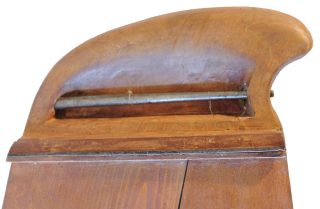
From below, the ponsi has also been shaped with care and consideration.
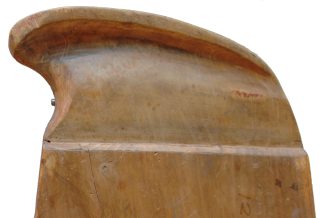
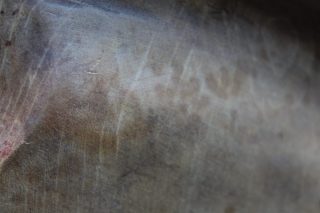 There are also vague traces of a darker colour on the underside of the ponsi – writing? Ha – obviously a message from somewhere out there!
There are also vague traces of a darker colour on the underside of the ponsi – writing? Ha – obviously a message from somewhere out there!
And the icing on the cake: the sound hole is truly sci-fi.
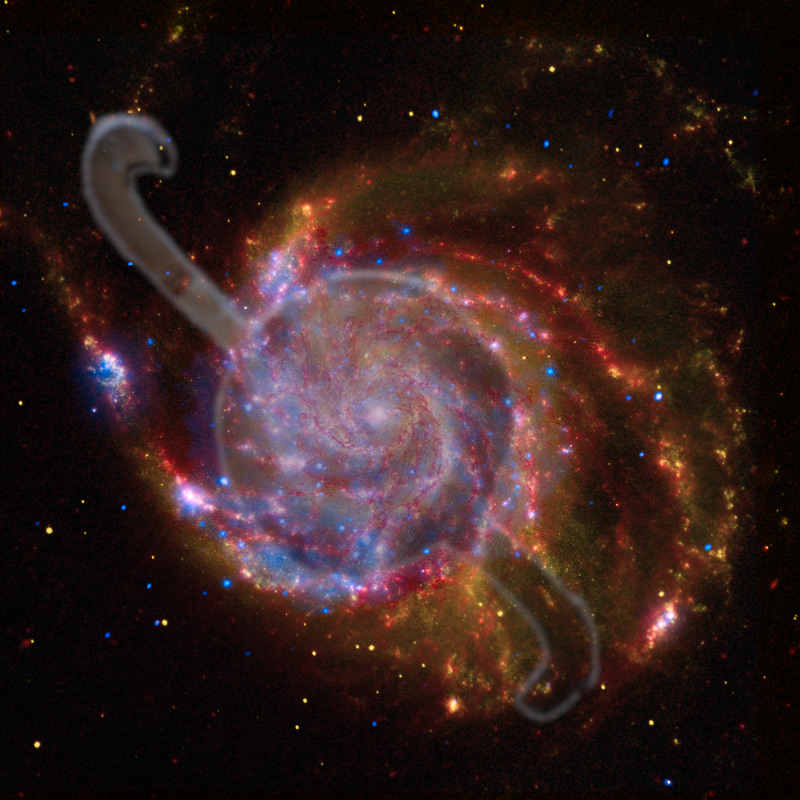
The shape of SM124’s soundhole seen from inside as part of galaxy M101 (Hubblesite). Image Credits: NASA, ESA, CXC, SSC, and STScI. “This image of the spiral galaxy Messier 101 is a composite of views from the Spitzer Space Telescope, Hubble Space Telescope, and Chandra X-ray Observatory. Each wavelength region shows different aspects of celestial objects and often reveals new objects that could not otherwise be studied.”
